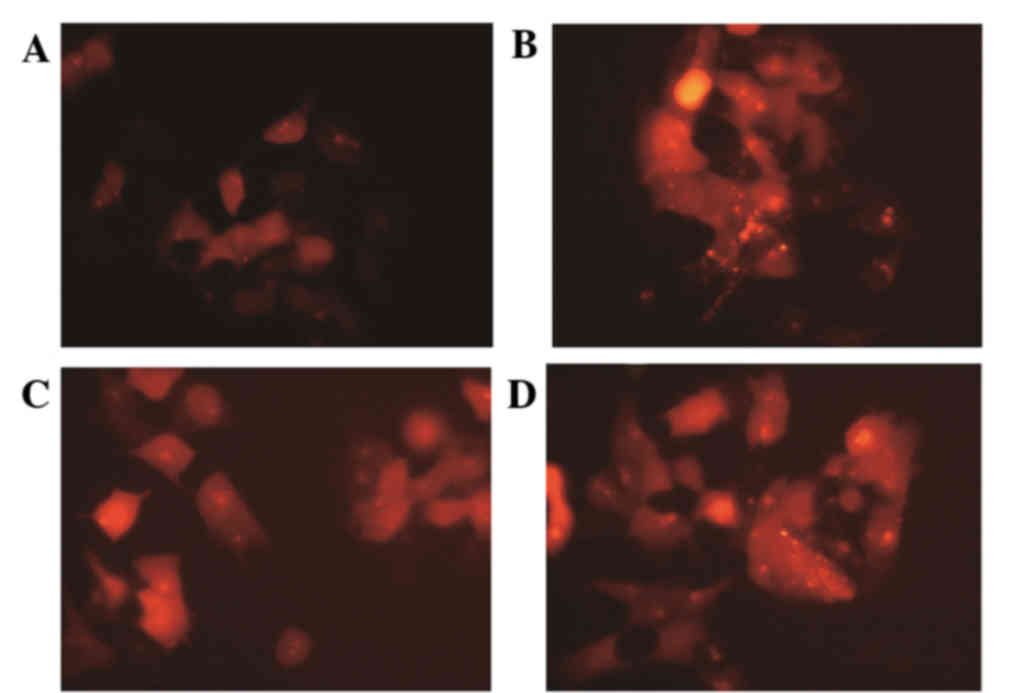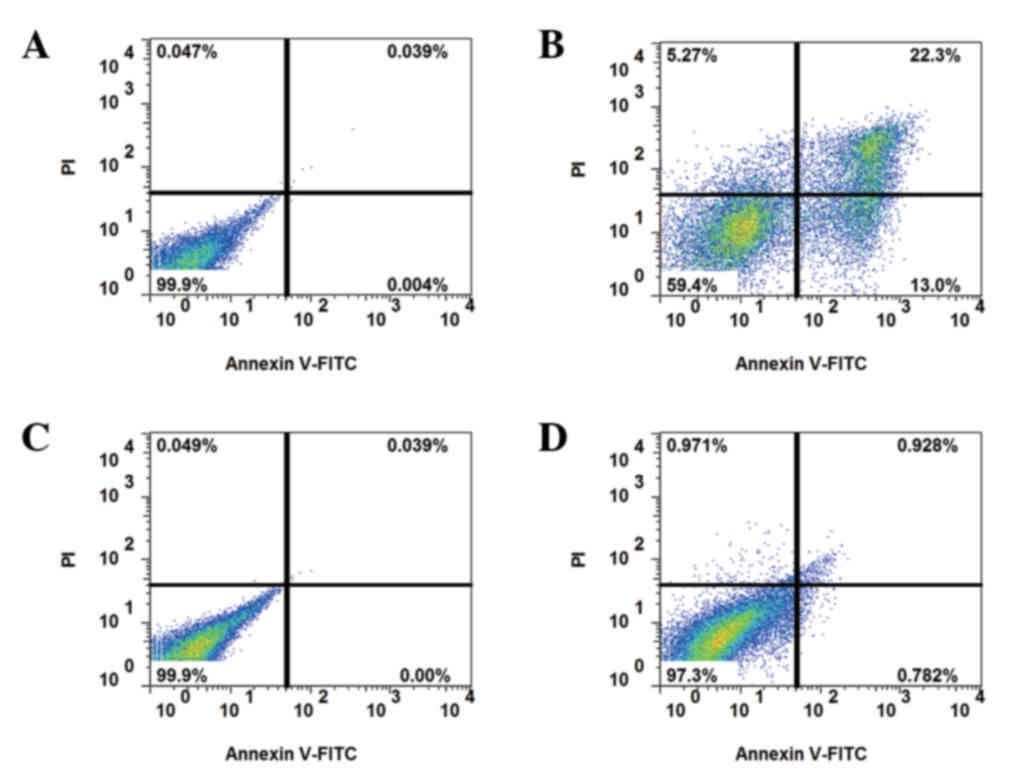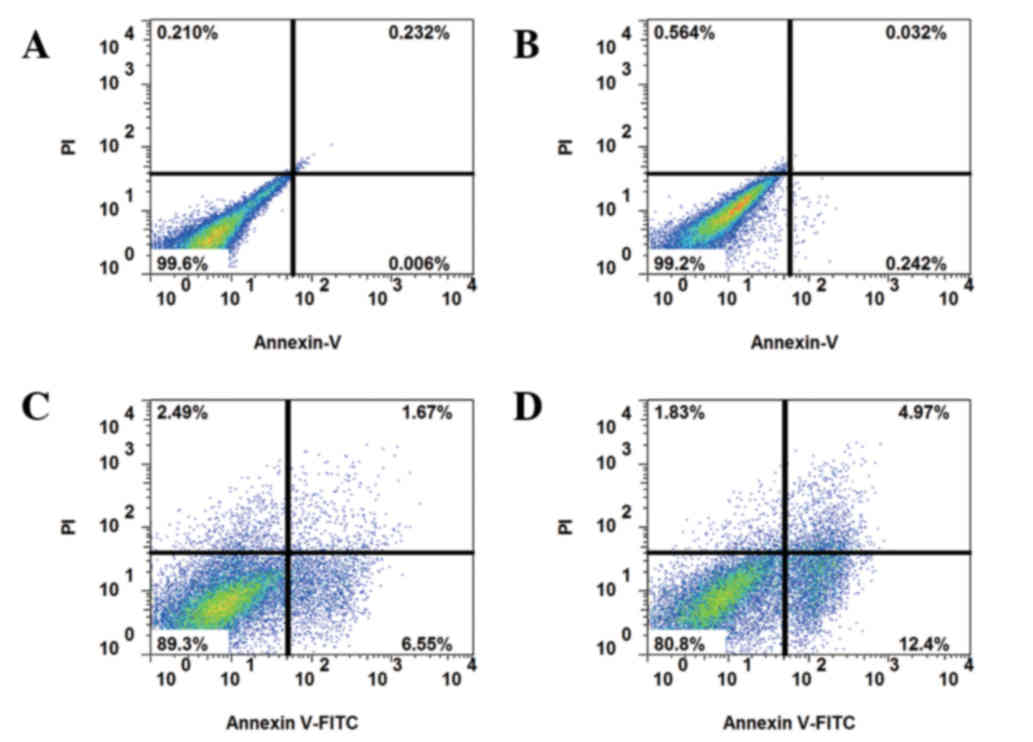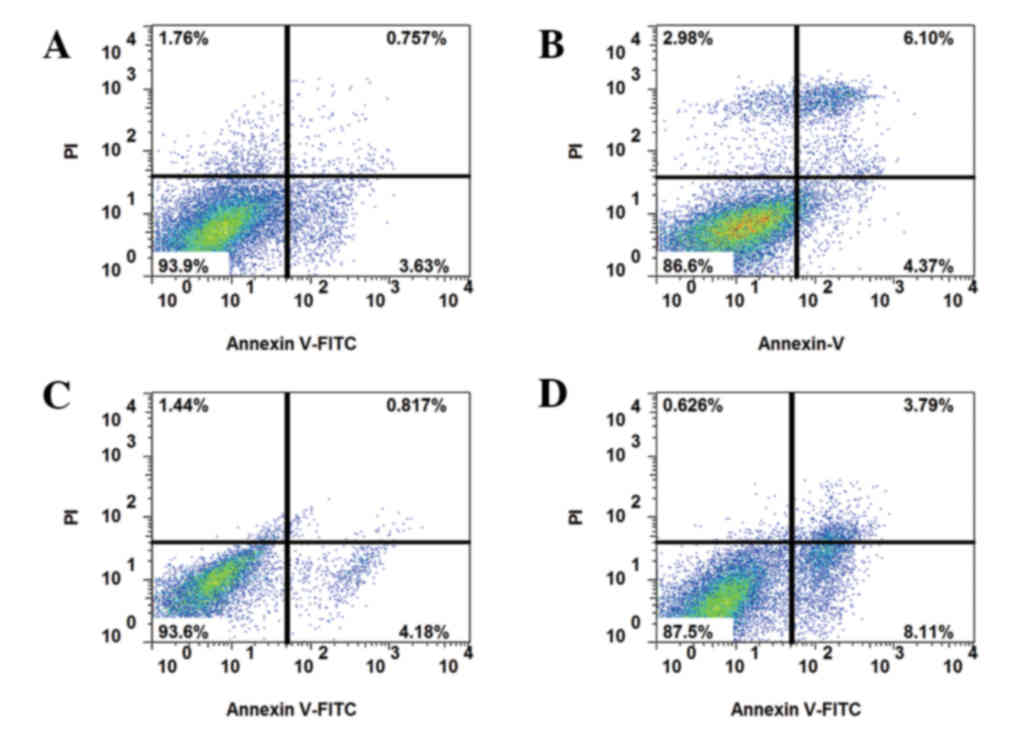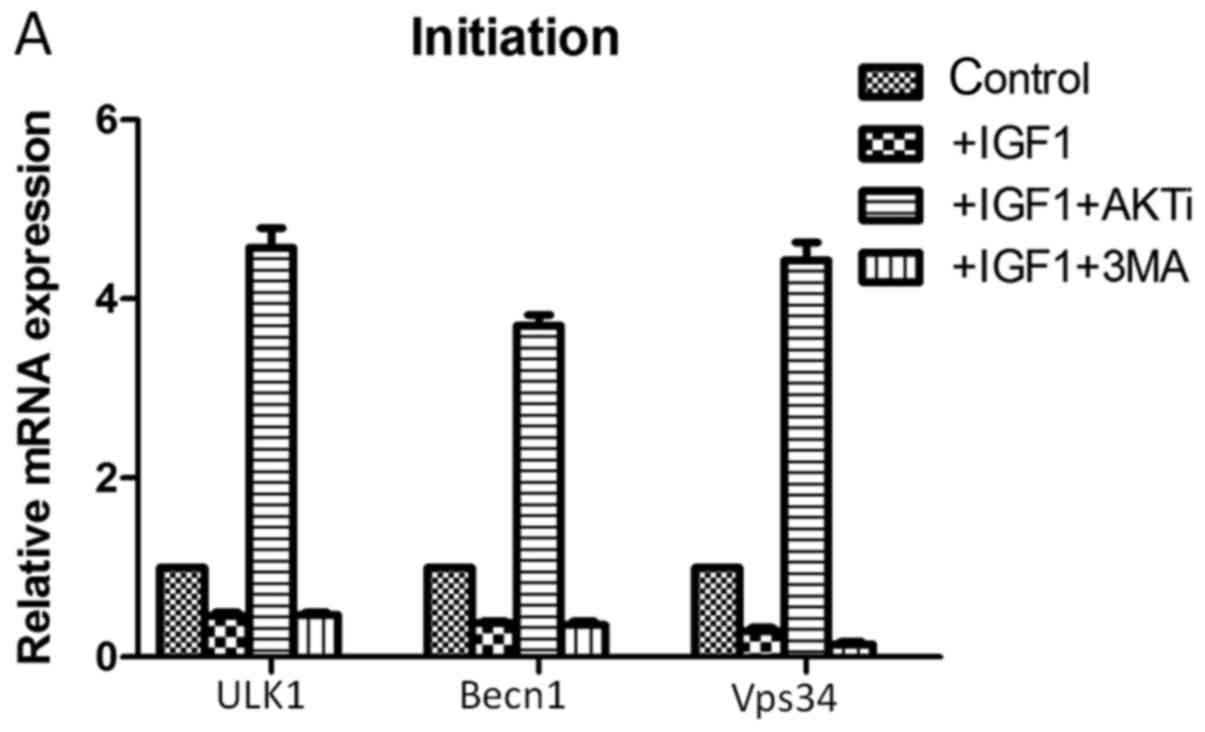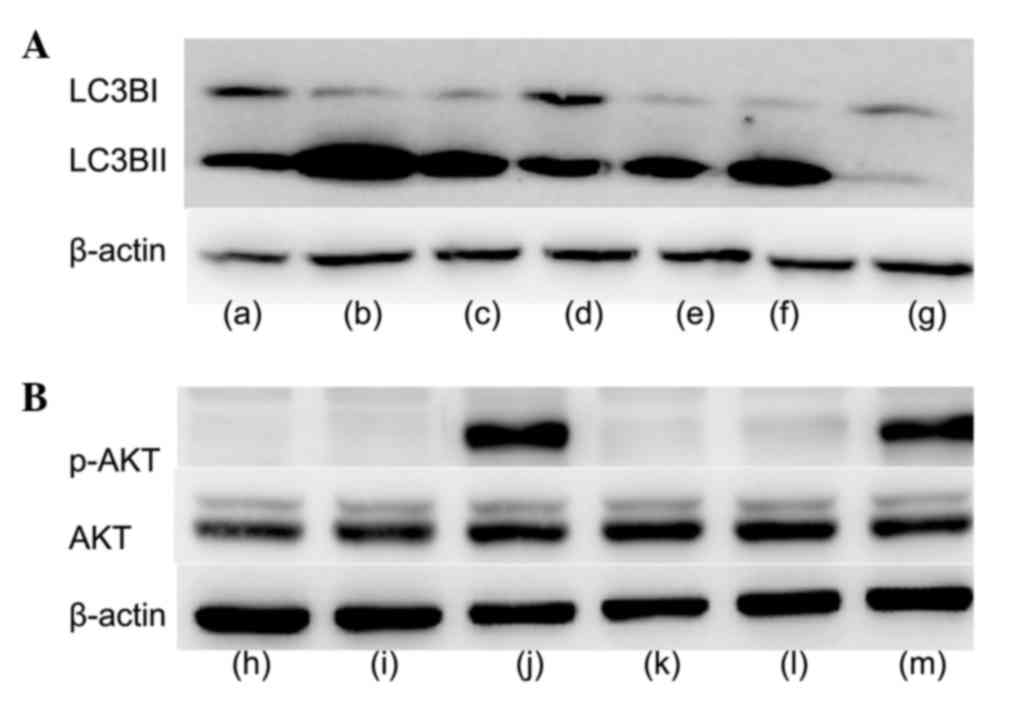Insulin-like growth factor 1 inhibits autophagy of human colorectal carcinoma drug-resistant cells via the protein kinase B/mammalian target of rapamycin signaling pathway
- Authors:
- Published online on: December 12, 2017 https://doi.org/10.3892/mmr.2017.8272
- Pages: 2952-2956
-
Copyright: © Wang et al. This is an open access article distributed under the terms of Creative Commons Attribution License.
Abstract
Introduction
Colorectal cancer is one of the most common types of cancer worldwide and the incidence is increasing (1). Although progress has been made with regard to treatment of colorectal cancer, patient survival remains poor (2). Currently, the primary drugs used for the treatment of colorectal cancer are oxaliplatin and 5-fluorouracil (5-FU) (3). How autophagy determines and regulates the sensitivity of colorectal cancer cells to 5-FUremainsunclear and requires investigation.
Autophagy is a degradation process that has important roles in cellular homeostasis (4). Despite its simplicity, evidence has demonstrated that autophagy is a highly complex process, involving protein degradation, organelle turnover and breakdown of cytoplasmic components during nutrient starvation or stress (5). Autophagy contributes to apoptosis when it is executed excessively or inefficiently (6). It has been suggested that autophagy serves a fundamental role in tumor progression (7–10).
Insulin-like growth factor-1 (IGF-1) has been reported to regulate cell survival, proliferation, differentiation and metabolism (11–13). IGF-1 has an inhibitory role on autophagy in various cell types, including human osteocarcinoma cells (11). However, little is known regarding the mechanisms underlying its inhibitory effect on autophagy in drug-resistant human colorectal carcinoma cells (HCT).
Therefore, the aim of the present study was to analyze the inhibitory effect of IGF-1 on autophagy in drug-resistant HCT, and its underlying mechanism.
Materials and methods
Cell culture
HCT-8 human HCT and HCT-8R5-FU-resistant HCT cells were obtained from Bogoo Biomart (Shanghai, China) The cells were cultured in RPMI-1640 medium (Gibco; Thermo Fisher Scientific, Inc., Waltham, MA, USA) containing 10% fetal bovine serum (Gibco; Thermo Fisher Scientific, Inc.), 2 mM L-glutamine, 100 U/ml penicillin and 100 ng/ml streptomycin at 37°C in a humidified atmosphere of 95% air. The medium was replaced every 2 days.
Autophagy analysis using the DsRed-microtubule-associated protein 1A/1B-light chain 3 (LC3)reporter
To develop an autophagy reporter, DsRed protein was fused with the N-terminus of the human LC3 protein through transfecting 293T cells with a lentivirus. Recombinant lentiviruses expressing the DsRed-LC3 reporter were generated and applied to infect target cells (14).
Apoptosis assays
For apoptosis assays, cells were seeded at 5×105 cells/ml in triplicate and starved with serum-free medium for 24 h, and subsequently treated with 10 or 50 nM IGF-1 [Phoenix Biotech (Beijing) Co., Ltd., Beijing, China], 10 nM MK-2206 (Selleck Chemicals, Houston, TX, USA) or 100 nM 3-methyladenine (MA; Sigma-Aldrich; Merck KGaA, Darmstadt, Germany) in combination with 10 µg/ml 5-FU (Kyowa Hakko Kirin Co., Ltd., Tokyo, Japan). After 24 h, cells were stained with 5 µl annexin V-fluorescein isothiocyanate and propidium iodide (PI; Invitrogen, Thermo Fisher Scientific, Inc.) for 15 min at room temperature and analyzed by flow cytometry (BD FACSCalibur™; BD Biosciences, Franklin Lakes, NJ, USA) using Flowjo software (version 10; Tree Star, Inc., Ashland, OR, USA).
Reverse transcription-quantitative polymerase chain reaction (RT-qPCR) analysis
HCT-8R cells were treated with IGF-1, AKT inhibitor and 3-MA. Total RNA was extracted using the RNeasy kit (Qiagen GmbH, Hilden, Germany) and transcribed into cDNA with an RNA Reverse Transcriptase kit (Takara Bio, Inc., Otsu, Japan). qPCR was performed with a SYBR®Green PCR assay (Takara Bio, Inc.) according to the manufacturer's protocol (95°C for 1 min, and 40 cycles of 95°C for 5 sec and 60°C for 35 sec, followed by a final standard dissociation protocol), using the primers listed in Table I. Expression of GAPDH served as an internal control. The results were analyzed using the comparative Cq method (2-ΔΔCq) (15).
Western blot analysis
HCT-8R cells were treated with IGF-1, AKT inhibitor and 3-MA. Cells (5×105 cells/ml) were lysed in radioimmunoprecipitation assay buffer (Beyotime Institute of Biotechnology, Haimen, China). The cell extracts were collected and diluted in SDS-loading buffer and denatured for 5 min at 95°C, and protein determination was performed using a bicinchoninic acid assay. The samples (30 µg) were separated using SDS-PAGE on a 12.5% gel and blotted onto 0.2 µm polyvinylidene difluoride membranes (Bio-Rad Laboratories, Inc., Hercules, USA). Following blocking with 5% skimmed milk powder in TBS containing Tween 20, membranes were incubated at 4°C overnightwithrabbit antibodies against LC3B (1:400, catalog no. ab48394; Abcam, Cambridge, UK), protein kinase B (1:400, AKT; catalog no. ab179463s; Abcam) and phosphorylated (p)-AKT (1:400, catalog no. ab81283; Abcam). Subsequently, membranes were incubated with a horseradish peroxidase-conjugated anti-rabbit secondary antibody at room temperature for 45 min (1:2,000; catalog no. sc-2357; Santa Cruz Biotechnology, Inc., Dallas, TX, USA) and proteins were visualized with an Enhanced Chemiluminescence system (PerkinElmer, Inc., Waltham, MA, USA). β-actin antibody (1:1,000; catalog no. sc-130656; Santa Cruz Biotechnology, Inc.) was used as an internal control.
Statistical analysis
Data are expressed as the mean ± standard deviation. A one-way analysis of variance and Scheffé post hoc test was applied to investigate significant differences among multiple groups. Statistical analysis was performed using SPSS software version 11.0 (SPSS, Inc., Chicago, IL, USA). P<0.05 was considered to indicate a statistically significant difference.
Results
Autophagy assay using the DsRed-LC3 reporter
Following culture for 24 h, autophagy in the drug-resistant cells increased. Autophagic bodies decreased following IGF-1 treatment (Fig. 1); however, this was reversed upon the addition of an AKT inhibitor.
Apoptosis assays
Apoptosis was detected by annexin V-PI staining. In non-resistant cells, apoptosis was increased by 5-FU treatment, whereas the resistant strain exhibited reduced apoptosis at 24 h following 5-FU treatment (Fig. 2). In order to reduce the inhibitory effect of serum on autophagy, the cells were serum-starved for 24 h, and subsequently cultured with 10 or 50 nM IGF-1 and 5-FU for a further 24 h. Eventually, apoptosis induced by 5-FU treatment was elevated by co-culture with IGF-1 in drug-resistant HCT-8R cells (Fig. 3). With the addition of the AKT inhibitor MK-2206 (10 nM) or autophagy agonist 3-MA (100 nM), apoptosis was decreased (Fig. 4).
RT-qPCR analysis
RT-qPCR was used to assess the effects of IGF-1 on the mRNA expression levels of autophagy-associated genes (Fig.5). In the initiation stage of autophagy, IGF-1 treatment downregulated the mRNA expression levels of the autophagy-associated genes unc-51 like autophagy activating kinase 1 (ULK1), beclin-1(Becn1) and phosphatidylinositol 3-kinase catalytic subunit type 3 (Vps34) in HCT-8cells (Fig. 5A). Treatment with IGF-1 and the AKT inhibitor MK-2206 significantly increased the mRNA expression levels of these genes; however, treatment with IGF-1 and 3-MA had no significant effect. In the elongation stage, a similar pattern was observed in the mRNA expression levels of autophagy related (Atg)5, Atg7 and Lc3b (Fig. 5B). In the expansion stage, IGF-1 downregulated the mRNA expression levels of Atg4b, Atg16l and Atg12, whereas addition of MK-2206 eliminated the inhibitory effect of IGF-1 (Fig. 5C).
Western blot analysis
As presented in Fig. 6A, LC3 protein expression levels increased following treatment with IGF-1, and decreased with the addition of IGF-1 and the AKT inhibitor MK-2206. Similarly, p-AKT protein expression levels increased with the addition of 50 nM IGF-1, and decreased with the addition of 10 or 50 nM IGF-1 and MK-2206 (Fig. 6B).
Discussion
Autophagy has been reported to serve an important role in cell death (4,6). The present study aimed to analyze the inhibitory effect of IGF-1 on autophagy in HCT-8R drug-resistant cells, and its potential underlying mechanisms.
In the present study, autophagic bodies decreased following IGF-1 treatment; this effect was reversed following the addition of an AKT inhibitor. This suggested that IGF-1 may inhibit autophagy by activating AKT. Through apoptosis analysis, IGF-1 was observed to increase sensitivity to apoptosis induced by 5-FU, which decreased upon the addition of an AKT inhibitor or 3-MA. These findings suggested that IGF-1 may inhibit autophagy via the AKT/mammalian target of rapamycin (mTOR) signaling pathway, and increase the sensitivity of resistant strains to 5-FU.
In a previous study, Lyu et al (16) revealed that peiminine resulted in cell death and promoted autophagic flux in HCT-116 cells, and suggested that peiminine enhanced autophagic flux by suppressing the phosphorylation of mTOR via the inhibition of upstream signals. In addition, Troncoso et al (11) reported that IGF-1 inhibits autophagy via the 5’ adenosine monophosphate-activated protein kinase/mTOR signaling pathway in addition to the AKT/mTOR signaling pathway. It has additionally been reported that inhibition of the mTOR signaling pathway induces autophagy and decreases cell viability (17,18).
The present study revealed that IGF-1 downregulated the mRNA expression levels of autophagy-associated genes involved in the three autophagy stages. Atg and Becn1 are important markers of autophagy (19–24). Previously, Jia et al (25) investigated the effect of IGF-1 on the expression of the autophagy-associated genes LC3 and Becn1 in vascular smooth muscle cells (VSMCs). Transmission electron microscopy revealed significantly reduced numbers of vacuolated cells in IGF-1-treated VSMCs compared with the untreated control group, andIGF-1 was demonstrated to inhibit the expression of autophagy-associated genes via the AKT signaling pathway. In the present study, LC3B-I and p-AKT protein expression levels increased following IGF-1 treatment, and decreased upon the addition of IGF-1 and an AKT inhibitor. These findings indicated that IGF-1 did not appear to promote apoptosis alone, although it increased sensitivity to apoptosis induced by 5-FU.
In conclusion, the results of the present study suggested that IGF-1 activated AKT and inhibited autophagy via the AKT/mTOR signaling pathway. Following inhibition of autophagy, drug-resistant HCT-8R cells became sensitive to 5-FU treatment, and treatment with 5-FU in combination with IGF-1 increased apoptosis.
References
|
Oliveira CS, Pereira H, Alves S, Castro L, Baltazar F, Chaves SR, Preto A and Côrte-Real M: Cathepsin D protects colorectal cancer cells from acetate-induced apoptosis through autophagy-independent degradation of damaged mitochondria. Cell Death Dis. 6:e17882015. View Article : Google Scholar : PubMed/NCBI | |
|
Cunningham D, Atkin W, Lenz HJ, Lynch HT, Minsky B, Nordlinger B and Starling N: Colorectal cancer. Lancet. 375:1030–1047. 2010. View Article : Google Scholar : PubMed/NCBI | |
|
Liu W, Zhang Z, Zhang Y, Chen X, Guo S, Lei Y, Xu Y, Ji C, Bi Z and Wang K: HMGB1-mediated autophagy modulates sensitivity of colorectal cancer cells to oxaliplatin via MEK/ERK signaling pathway. Cancer Biol Ther. 16:511–517. 2015. View Article : Google Scholar : PubMed/NCBI | |
|
Hayashi-Nishino M, Fujita N, Noda T, Yamaguchi A, Yoshimori T and Yamamoto A: A subdomain of the endoplasmic reticulum forms a cradle for autophagosome formation. Nat Cell Biol. 11:1433–1437. 2009. View Article : Google Scholar : PubMed/NCBI | |
|
Mizushima N: Autophagy: process and function. Genes Dev. 21:2861–2873. 2007. View Article : Google Scholar : PubMed/NCBI | |
|
Galluzzi L, Morselli E, Vicencio JM, Kepp O, Joza N, Tajeddine N and Kroemer G: Life, death and burial: Multifaceted impact of autophagy. Biochem Soc Trans. 36:786–790. 2008. View Article : Google Scholar : PubMed/NCBI | |
|
Rubinsztein DC, Codogno P and Levine B: Autophagy modulation as a potential therapeutic target for diverse diseases. Nat Rev Drug Discov. 11:709–730. 2012. View Article : Google Scholar : PubMed/NCBI | |
|
Zhou WH, Tang F, Xu J, Wu X, Yang SB, Feng ZY, Ding YG, Wan XB, Guan Z, Li HG, et al: Low expression of Beclin 1, associated with high Bcl-xL, predicts a malignant phenotype and poor prognosis of gastric cancer. Autophagy. 8:389–400. 2012. View Article : Google Scholar : PubMed/NCBI | |
|
Yang M, Zhao H, Guo L, Zhang Q, Zhao L, Bai S, Zhang M, Xu S, Wang F, Wang X and Zhao B: Autophagy-based survival prognosis in human colorectal carcinoma. Oncotarget. 6:7084–7103. 2015. View Article : Google Scholar : PubMed/NCBI | |
|
Guo GF, Jiang WQ, Zhang B, Cai YC, Xu RH, Chen XX, Wang F and Xia LP: Autophagy-related proteins Beclin-1 and LC3 predict cetuximab efficacy in advanced colorectal cancer. World J Gastroenterol. 17:4779–4786. 2011. View Article : Google Scholar : PubMed/NCBI | |
|
Troncoso R, Vicencio JM, Parra V, Nemchenko A, Kawashima Y, Del Campo A, Toro B, Battiprolu PK, Aranguiz P, Chiong M, et al: Energy-preserving effects of IGF-1 antagonize starvation-induced cardiac autophagy. Cardiovasc Res. 93:320–329. 2012. View Article : Google Scholar : PubMed/NCBI | |
|
Ikeda H, Shiojima I, Ozasa Y, Yoshida M, Holzenberger M, Kahn CR, Walsh K, Igarashi T, Abel ED and Komuro I: Interaction of myocardial insulin receptor and IGF receptor signaling in exercise-induced cardiac hypertrophy. J Mol Cell Cardiol. 47:664–675. 2009. View Article : Google Scholar : PubMed/NCBI | |
|
Sekharam M, Nasir A, Kaiser HE and Coppola D: Insulin-like growth factor 1 receptor activates c-SRC and modifies transformation and motility of colon cancer in vitro. Anticancer Res. 23:1517–1524. 2003.PubMed/NCBI | |
|
Yao W, Dai W, Jiang L, Lay EY, Zhong Z, Ritchie RO, Li X, Ke H and Lane NE: Sclerostin-antibody treatment of glucocorticoid-induced osteoporosis maintained bone mass and strength. Osteoporos Int. 27:283–294. 2016. View Article : Google Scholar : PubMed/NCBI | |
|
Schmittgen TD and Livak KJ: Analyzing real-time PCR data by the comparative C(T) method. Nature Protoc. 3:1101–1108. 2008. View Article : Google Scholar | |
|
Lyu Q, Tou F, Su H, Wu X, Chen X and Zheng Z: The natural product peiminine represses colorectal carcinoma tumor growth by inducing autophagic cell death. Biochem Biophys Res Commun. 462:38–45. 2015. View Article : Google Scholar : PubMed/NCBI | |
|
Lin CW, Jan MS and Kuo JH: Exploring MicroRNA Expression Profiles Related to the mTOR Signaling Pathway in Mouse Embryonic Fibroblast Cells Treated with Polyethylenimine. Mol Pharm. 12:2858–2868. 2015. View Article : Google Scholar : PubMed/NCBI | |
|
Sobolewska A, Gajewska M, Zarzynska J, Gajkowska B and Motyl T: IGF-I, EGF, and sex steroids regulate autophagy in bovine mammary epithelial cells via the mTOR pathway. Eur J Cell Biol. 88:117–130. 2009. View Article : Google Scholar : PubMed/NCBI | |
|
Schwartz-Roberts JL, Cook KL, Chen C, Shajahan-Haq AN, Axelrod M, Warri A, Riggins RB, Jin L, Haddad BR, Kallakury BV, Baumann WT and Clarke R: Interferon regulatory factor-1 signaling regulates the switch between autophagy and apoptosis to determine breast cancer cell fate. Cancer Res. 75:1046–1055. 2015. View Article : Google Scholar : PubMed/NCBI | |
|
Klionsky DJ, Cregg JM, Dunn WA Jr, Emr SD, Sakai Y, Sandoval IV, Sibirny A, Subramani S, Thumm M, Veenhuis M and Ohsumi Y: A unified nomenclature for yeast autophagy-related genes. Dev Cell. 5:539–545. 2013. View Article : Google Scholar | |
|
Liang XH, Jackson S, Seaman M, Brown K, Kempkes B, Hibshoosh H and Levine B: Induction of autophagy and inhibition of tumorigenesis by beclin 1. Nature. 402:672–676. 1999. View Article : Google Scholar : PubMed/NCBI | |
|
Betin VM and Lane JD: Caspase cleavage of Atg4D stimulates GABARAP-L1 processing and triggers mitochondrial targeting and apoptosis. J Cell Sci. 122:2554–2566. 2009. View Article : Google Scholar : PubMed/NCBI | |
|
Yousefi S, Perozzo R, Schmid I, Ziemiecki A, Schaffner T, Scapozza L, Brunner T and Simon HU: Calpain-mediated cleavage of Atg5 switches autophagy to apoptosis. Nat Cell Biol. 8:1124–1132. 2006. View Article : Google Scholar : PubMed/NCBI | |
|
Nikoletopoulou V, Markaki M, Palikaras K and Tavernarakis N: Crosstalk between apoptosis, necrosis and autophagy. Biochim Biophys Acta. 1833:3448–3459. 2013. View Article : Google Scholar : PubMed/NCBI | |
|
Jia G, Cheng G, Gangahar DM and Agrawal DK: Insulin-like growth factor-1 and TNF-alpha regulate autophagy through c-jun N-terminal kinase and Akt pathways in human atherosclerotic vascular smooth cells. Immunol Cell Biol. 84:448–454. 2006. View Article : Google Scholar : PubMed/NCBI |



